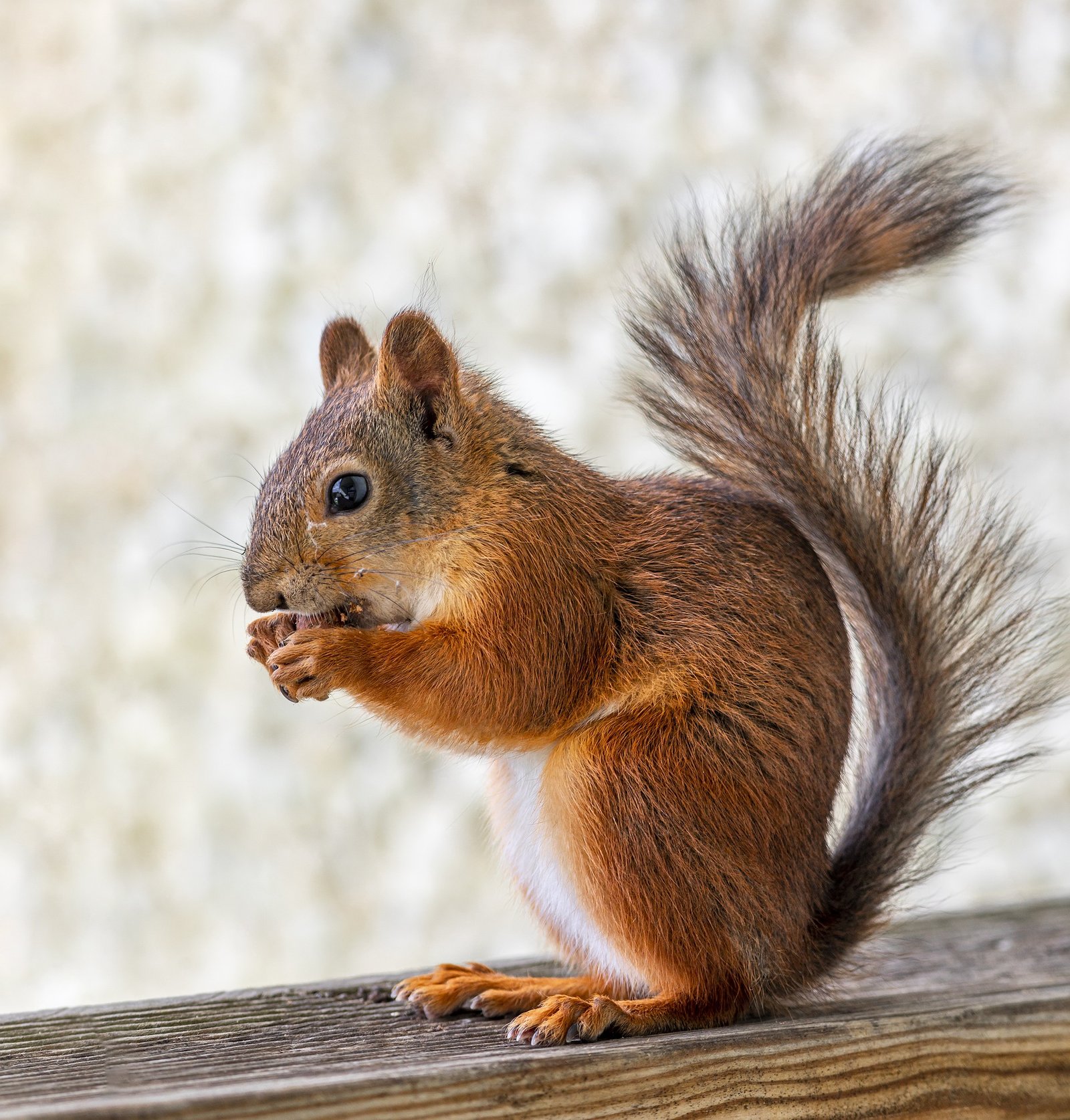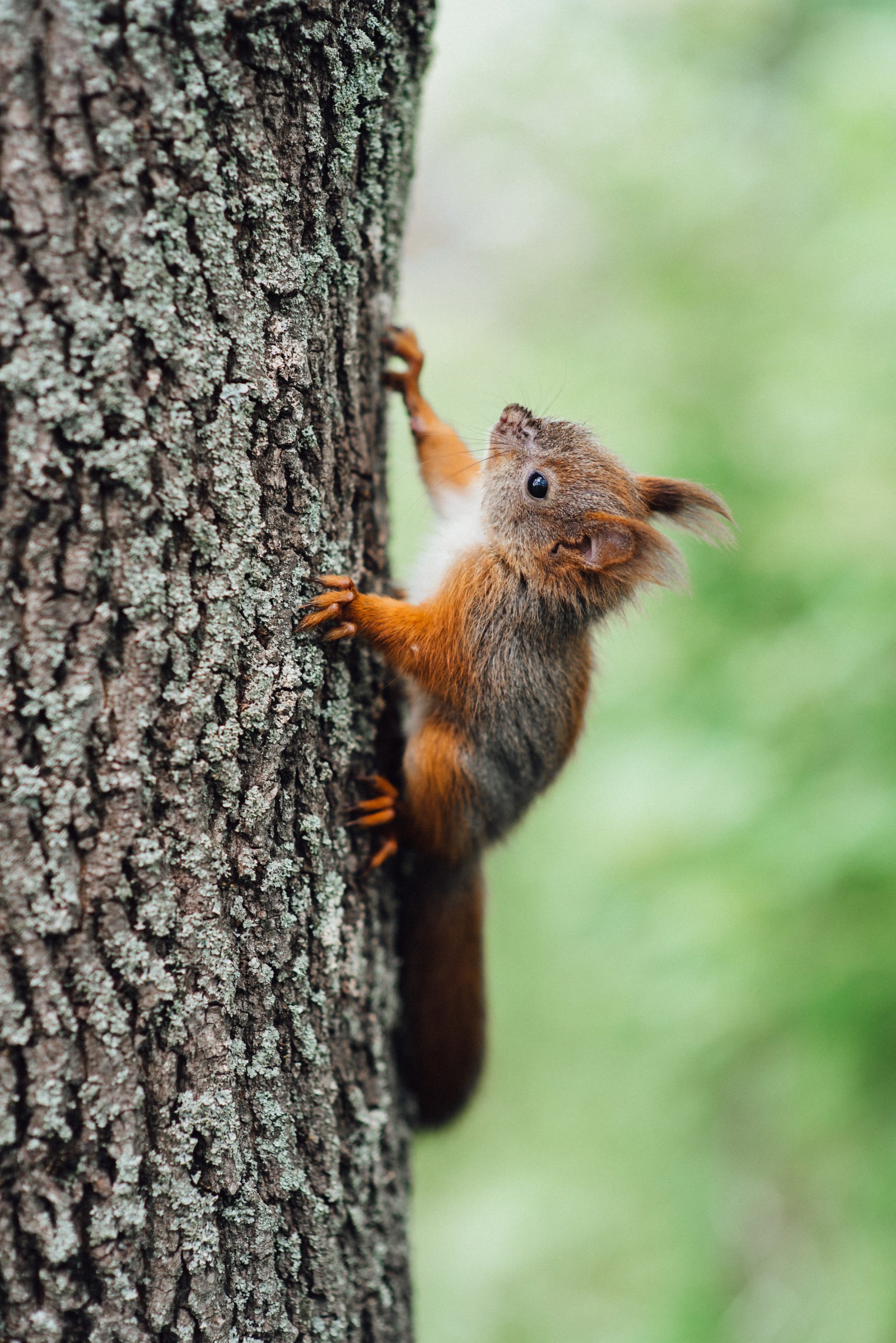Red Squirrel: Tamiasciurus Hudsonicus

Description Of The Red Squirrel
Unlike other squirrels living in trees, red squirrels look different because they are small and have deep reddish fur. They’re much smaller than the common gray squirrel and have a reddish back and white underside that easiest to see in summer. They have a reddish-brown or olive-gray back but usually have a reddish or brownish band in the center.
Red squirrels have tails that are small and flat with a black band along it. The band on the tail can also be yellowish-gray or rusty red. Red squirrels, male and female, are very difficult to tell apart.
Learn More: Squirrel Distribution In The U.S.
Red Squirrel Size
In some places, red squirrels may be slightly larger or smaller, but they weigh 200 to 250 g on average. They have a length of 270 to 385 mm. This includes their tail, which, by itself, is 92 to 158 mm long. Their back legs are between 35 and 57 mm long, and their ears are between 19 and 31 mm long.
Red squirrels put all their new fur on their bodies twice a year and on their tails once a year. This shift helps researchers figure out how old they are. So their teeth are studied for permanent teeth and signs of wear. There are 20 or 22 teeth in red squirrels. 1Go To Source biokids.umich.edu -“Red squirrel Tamiasciurus hudsonicus”
Behavior Of Red Squirrels

During the day, red squirrels are most active, but sometimes they are active during the night. The mornings and afternoons are their most active periods in spring and summer, but they are very active all day, coming into autumn as they get ready for the winter food shortages.
Male and female squirrels will defend exclusive territories vigorously against rivals. The red squirrel is a solitary creature, aside from mothers with their young. The nest is called a drey and can be made in various places, such as hollows or crotches of trees, or hollows in the soil or in logs. It’s a very vocal animal that makes chattering, growling, and screeching sounds. 2Go To Source animalia.bio -“AMERICAN RED SQUIRREL Red squirrel, Pine squirrel, North American red squirrel, Boomer, Chickaree”
Red Squirrel Reproduction
The courtship between a pair of red squirrels that precedes mating is brief and relatively non-ritualized. During its one-day estrous period, one to 10 males may follow a female, the dominant male eventually approaching the female while giving quiet vocalizations and then mounting her. Copulation is brief, but before the female becomes aggressive, it can recur several times. Some women may mate with multiple males.
After a gestation period of 36-40 days, in a shredded bark nest and leaves, the female bears its young. There is a typical litter of 3-5 young squirrels, but it can vary from 1-8.
At birth, blind, naked, and pink, the young develop slowly, not opening their eyes until the age of 27 days. They are fully furred by day 30, and they start venturing from the nest. Soon after, they’re weaned. They set up their own territory at 9-11 weeks of age.
In both April and August, some females produce a litter, but others produce only one litter annually during one of these periods. In the winter after their birth, the sexual maturation of the young occurs. Red squirrels may live for 10 years, although adults’ average life span is 3-5 years. 3Go To Source esf.edu -“Red Squirrel (Tamiasciurus hudsonicus)”
Diet Of Red Squirrels

A red squirrel will rely on a wide range of foods, including insects, seeds, bark, nuts, fruits, mushrooms, and pine seeds or cones. Sometimes it will eat rabbits, young birds, insects, young birds, and mice, but pine seeds are the majority of its diet.
It will cut green pine cones from trees in the fall and store them in the soil. It also keeps nuts and seeds in piles or middens under logs, at the base of trees, and underground. It doesn’t always find or eat all of its stored seeds and nuts. The red squirrel fills an essential niche in spreading seeds in the forest because of this.
When the food supply is low, the red squirrel will migrate short distances. The red squirrel also drinks the sap from maple. Once the water in the sap has evaporated, the squirrel bites a tree until the sap flows out and comes back to drink it. 4Go To Source nhpbs.org -“Red Squirrel – Tamiasciurus hudsonicus”
Red Squirrel Habitat
Red squirrels are little mammals that require adult tree species because they live in trees. Two kinds of forests, broadleaf and coniferous, are preferred. There are large, adult trees in these forests with plenty of seeds and nuts for the squirrels to eat.
Mature trees also allow the squirrels to create nests far from the ground in secure locations. These squirrels also sometimes live in more urban areas because parks usually plant similar tree species. 5Go To Source animals.net -“Red Squirrel”
Range Of The Red Squirrel Species

Including the forests of Alaska, the east coast north of Georgia, and the Rocky Mountains, American red squirrels can be found all around the United States. This squirrel species can be found in most coniferous forests of North America. 6Go To Source nwf.org -“American Red Squirrel Tamiasciurus hudsonicus”
Top 5 Predators Of Red Squirrel’s
- Weasels
- Gray Foxes
- Coyotes
- Raptors
- Bobcats
Threats To Red Squirrels
In both the United States and Britain, red squirrels are under increasing threat from the human population and its pets.
Road traffic accidents, domestic dog and cat attacks, and a cat-related parasitic disease account for many deaths in this species. Rat traps, poisoning of rat bait, and electrocution are among other causes of red squirrel deaths related to humans.
In the red squirrel species, illnesses and cancer have also been recorded. The most common disease is squirrel-pox, and any red squirrel can carry it without symptoms.
Sources:
- Rubin, C. 2012. “Tamiasciurus hudsonicus” (On-line), Animal Diversity Web. Accessed January 26, 2021 at http://www.biokids.umich.edu/accounts/Tamiasciurus_hudsonicus/
- “American Red Squirrel – Facts, Diet, Habitat & Pictures on Animalia.Bio.” Animalia, Animalia, animalia.bio/american-red-squirrel. Accessed 26 Jan. 2021.
- Saunders, A. “Red Squirrel | Adirondack Ecological Center | SUNY ESF | College of Environmental Science and Forestry.” SUNY College Of Environmental Science And Forestry, State University of New York, 1988, www.esf.edu/aec/adks/mammals/redsquirrel.htm.
- “Red Squirrel – Tamiasciurus Hudsonicus – NatureWorks.” NHPBS, New Hampshire PBS, nhpbs.org/natureworks/redsquirrel.htm. Accessed 26 Jan. 2021.
- Oldham, Cydni. “Red Squirrel.” Animals Network, Animals.NET, 3 Apr. 2019, animals.net/red-squirrel.
- “American Red Squirrel.” National Wildlife Federation, National Wildlife Federation, www.nwf.org/Educational-Resources/Wildlife-Guide/Mammals/Red-Squirrel. Accessed 26 Jan. 2021.
